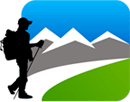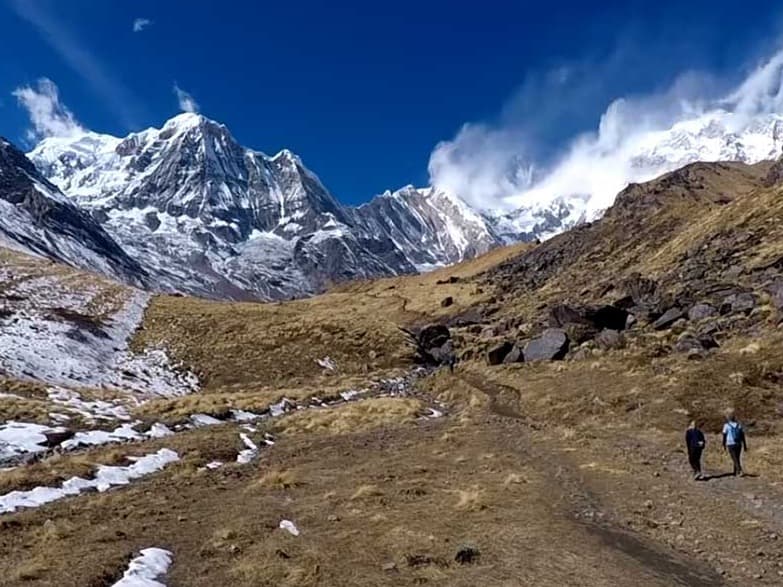The Upper Mustang is a remote and isolated region in the Himalayas of Nepal. It is a dry Trans-Himalayan zone stretching out at the foothills of the towering mountains and bordering the Tibetan plateau. The Upper Mustang region is an extraordinary destination for unique trekking experiences. This undiscovered treasure in the northcentral part of the country is a harmonious blend of natural and cultural splendor. The desert-like geographical features, spectacular landscapes (eroded canyons, colorful rock formations, giant cliffs, etc.), distinctive Tibetan Buddhist culture, ancient cultural heritages, centuries-old cave dwellings, etc, reveal the exciting story of this secluded region.
But when is the best time for the Upper Mustang Trek? It is important to understand and select the perfect time to embark on this mountainous journey before you pack your bags and tie your shoelaces. Choosing the month to visit the Upper Mustang depends on your interests, preferences, available travel time, budget, and several other factors. However, the time of year and weather during that particular period are what define your overall trekking experience. So, for the easy, smooth, safe, comfortable, and enriching experience of the Upper Mustang Trek, choose the time carefully, as the weather and temperature vary greatly throughout the year.
For a remarkable trekking experience, you need to plan your journey during a time that could provide you with optimal weather conditions and enriching encounters with the nature and culture of the destination region. So, which month is best for Upper Mustang? The best time for the Upper Mustang Trek is usually considered from the March to November months. During this time, the weather in the Mustang region remains stable and pleasant. The temperature is moderate and comfortable for trekking activities. The sky is clear, offering the grand views of the snow-clad Himalayas. These spring and autumn months reveal the breathtaking beauty of the highlands landscapes and vibrant hues of nature. Besides, you can also gain deep insights into the unique local culture and even partake in the festival celebrations that take place in the local villages during your journey.
The Upper Mustang region is also ideal for the monsoon trek. Monsoon has no effect on the journey as the region lies within the rain shadow area of the Himalayas. With no heavy monsoon rain in this arid region, Upper Mustang is a splendid destination for summer/monsoon treks. So, planning the Upper Mustang Trek during the June to August months is also a wonderful decision.
Month-by-Month Climate Analysis of the Upper Mustang Region
| Months | Weather Patterns | Temperature Ranges |
| January | Very cold | -10 to -5 degrees Celcius |
| February |
Cold and frosty Clear skies |
-5 to 10 degrees Celcius |
| March | Reduced cold and dry |
5 to 15 degrees Celcius |
| April | Sunny |
8 to 18 degrees Celcius |
| May | Gentle heat |
10 to 20 degrees Celcius |
| June | Humid |
15 to 25 degrees Celcius |
| July | Hot and wet |
16 to 26 degrees Celcius |
| August | Warm |
15 to 24 degrees Celcius |
| September | Bright Days and clear skies | 12 to 20 degrees Celcius |
| October | Dry and warm | 8 to 18 degrees Celcius |
| November | Dry, clear, and cool | 3 to 15 degrees Celcius |
| December | Cold |
-5 to 10 degrees Celcius |
Upper Mustang Trek in Different Seasons
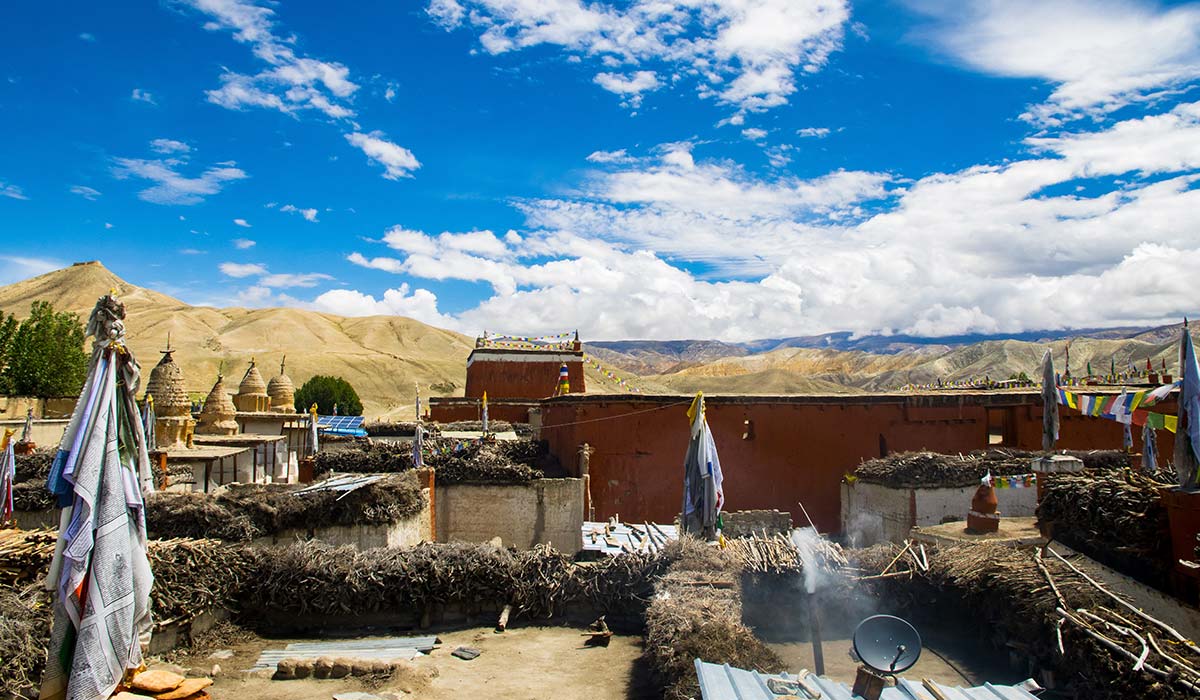
Spring (March, April, and May)
Spring is an ideal time to embark on the high-altitude Himalayan treks in Nepal. It isSo, it is also the best time for Upper Mustang Trek. Spring is a pre-monsoon phase with generally mild temperatures and stable weather conditions. It is a beautiful blooming season, succeeding winter and preceding summer/monsoon. The Upper Mustang Trek during the spring season lets you experience the allure of nature in its finest form while enjoying the comfort of pleasant Himalayan climates.
The nature begins to renew and grow with the arrival of spring. The lower region forests are decorated with the vibrant colors of rhododendron bloom. While traversing the forested trails, you can find yourself walking beneath the shades of densely blooming red, pink, white, yellow, purple, and orange rhododendrons, along with several other wildflowers. The crisp air carries the sweet fragrance of blossoming flowers, delighting the weary trekkers along their mountainous paths. Besides, tree leaves start to emerge, and new vegetation grows in the Himalayan landscapes, adding a hypnotic emerald color to nature. The soothing melody of a bird’s chirp can be heard, coming somewhere from the new-leaf branches. The magnificently painted trails with diverse hues of flora and lush greenery mesmerize the trekkers venturing into the Upper Mustang region during spring.
The stable weather in spring is characterized by gentle/mild winds, clear skies, reduced precipitation, low humidity, etc. The climate is dry, with no risk of heavy snowfall and downpours. Due to this, the trekking trails remain unwet and clean, facilitating easier walks in the remote Upper Mustang regions. The moderate temperature of spring, usually ranging between 15 to 20 degrees Celcius will allow you for a comfortable daytime trekking. As the early morning and nighttime temperatures at higher elevations can be a bit chilly, consider packing warm clothes to stay cozy and comfortable.
Summer/Monsoon (June, July, and August)
A monsoon is a wet summertime with heavy rainfall and hot climatic conditions. During this period, you will experience intense sunlight while trekking the Upper Mustang region. The scorching sun will trouble your outdoor trekking journey, making you sweat excessively. Due to the hot temperature, which is somewhere between 20 and 25 degrees Celcius, the possibility of heatstroke and heat exhaustion increases.
Suddenly, a bright, sunny summer day can turn gloomy with dark rain clouds in the sky. While the temperature drops to a bearable range after the rain, the visibility in the surroundings is affected during the rainfall period. As a result, you cannot relish the beauty of the pristine white snow-covered Himalayas and lush mountainous environment. Still, there is a good side of monsoon that the rainfall usually occurs during the late evening, presenting the clear mornings. The rain-nourished vegetation and rain-washed environment look green and fresh. The views of the shining mountains are seen with greater clarity against the crystalline sky at this time. The rain sweeps away the dust and hazes in the atmosphere, contributing to the stark vision of the environment. You can breathe in the fresh mountain, and the gentle breeze will soothe your mind and body adding energy to continue further on the journey.
On the other hand, due to regular rain, the water level in rivers and lakes rises, leading to the possibility of floods and landscapes. The routes can get blocked due to the accumulation of debris. The heavy rain in the lower Mustang region makes the trails connecting to the Upper Mustang slippery and challenging to navigate. While you can face such difficulties in the lower trekking areas, the Upper Mustang region lies in the rain shadow area of the Annapurna and Dhaulagiri Himalayan ranges and does not receive much rain. This trans-Himalayan zone remains arid and dry even in monsoon. So, there won't be any difficulty in venturing into the Upper Mustang region during this time.
Autumn (September, October, and November)
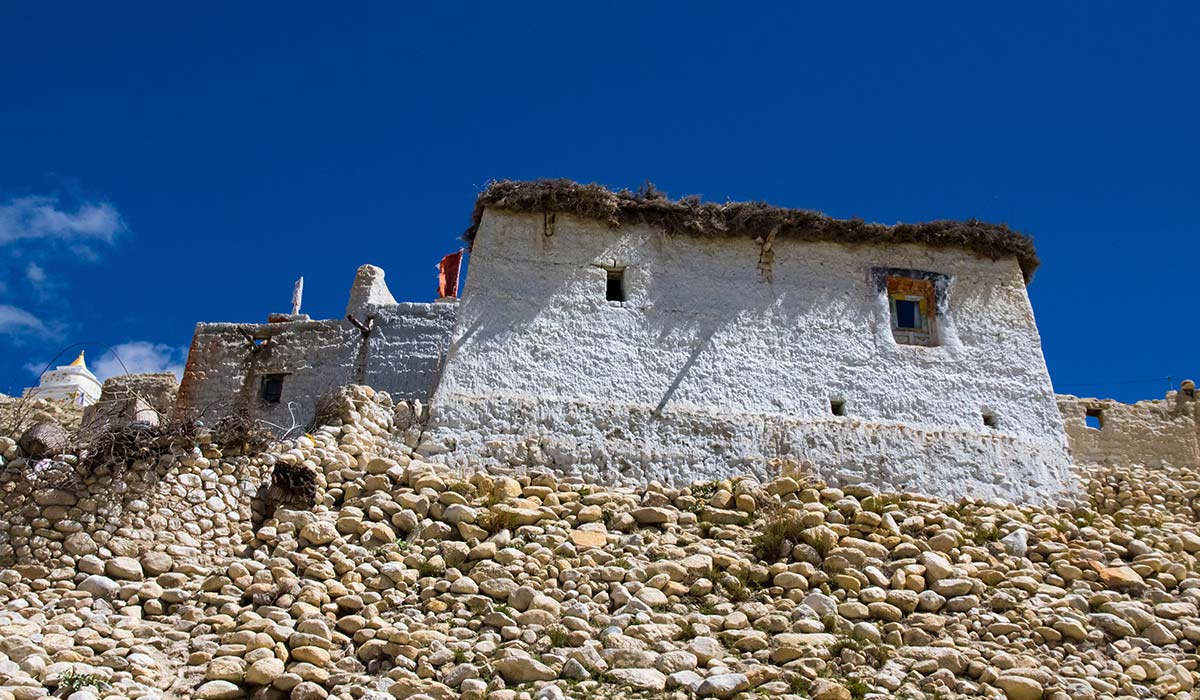
Autumn is a desirable season for adventure enthusiasts setting off to explore the Himalayas. It is the post-monsoon time, with stable weather conditions and mild temperatures, similar to spring. As the long, drenching monsoon settles in, you can experience a dry climate with scarce rain and snowfall during this time. There is no threat of natural calamities such as floods, landslides, avalanches, hurricanes, blizzards, etc, caused by unstable weather. The moderate temperature in autumn ranges from around 15 to 20 degrees Celcius. In gentle heat, which is neither too hot nor too cold, you can explore the Himalayas with comfort and ease.
The dry, sunny, and warm weather of autumn is ideal for smooth and enjoyable trekking in the Upper Mustang region. The nights are cool, with open and clear starry skies. There is utmost visibility in the surroundings, favored by the clear skies, fresh air, and low humidity. The snow-capped peaks glisten in the sunlight, mesmerizing the trekkers with awe and wonder. You can capture the stunning views of the towering Himalayas, widely spreading against the deep azure sky.
Trekking in the Upper Mustang region during the autumn season rewards visitors with its captivating fall foliage. The color-rich Himalayan landscapes painted by the diverse shades of yellow, orange, red, purple, and brown create a visual feast for the trekkers. The lower region forested trails are covered with piles of crimson-grey autumn leaves, and the hills are turned colorful. The soft rustling of the multi-colored foliage underfoot as you meander through peaceful woodland will leave you breathless. Furthermore, the stunning mountain ranges at the backdrop of magnificent autumn landscapes will enrich your trekking experience tenfold.
Winter (December, January, and February)
.jpg)
Winter is the coldest season, with heavy snowfall and frigid temperatures in the highland regions. With thick snow blanketing the landscapes, the Upper Mustang region during this time is transformed into a winter wonderland. The mountains are covered with chunky snow coates and glisten brightly upon the fall of golden sunrays in them. The sky is clear at this time, and you can see the stark views of the Himalayas. The exposed snowy peak’s panorama at the backdrop of your remote and wilderness Upper Mustang trekking journey in winter is like an otherworldly adventure. It is a great experience visiting the Upper Mustang region during this time to immerse in the pristine beauty and tranquility of the Himalayas.
Trekking the Upper Mustang region during winter lets you connect deeply to the untouched nature and immerse in the untampered local culture of the region with only a few people on the trail. As the competition for accommodation decreases, you will also have cheaper stays. However, the teahouses in alpine areas may get closed as people migrate to lower regions to avoid extreme coldness. So, it is essential to ensure the teahouse's availability and book the accommodations before going for the trek.
The average daytime temperature in winter hovers around 10 to 15 degrees Celcius. The temperature at the alpine locations, especially during the morning and night, drops significantly below the freezing scales. As the snow falls thickly in the higher altitudes, the temperature is extremely low. This can lead to cold-related illnesses such as Hypothermia and frostbite. So, to cope with the bitterly cold conditions and stay comfortable, you need to pack well with warm layers. The heavy snowfall also increases the difficulty of traversing the mountainous trails. The steep, narrow routes and passes can get blocked due to the accumulation of snow piles. Hence, for smooth and efficient navigation, carrying ice axes, crampons, gaiters, etc., is recommended.
Recommended Time to Go for the Upper Mustang Trek
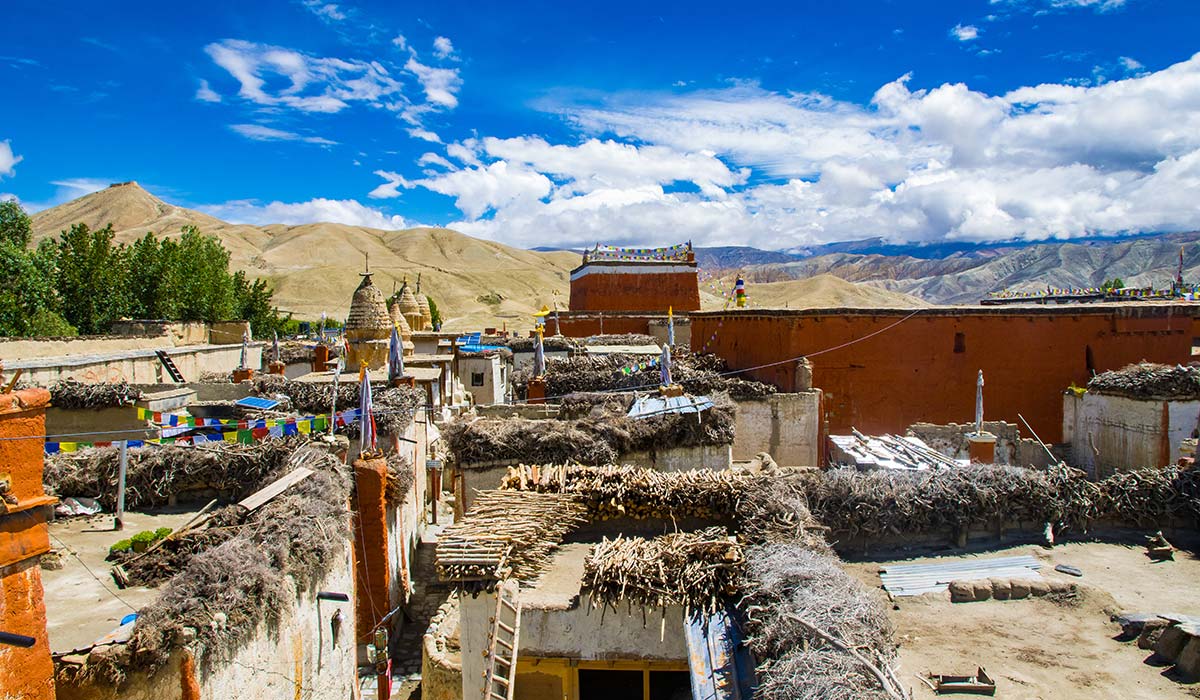
Spring and Autumn
Spring and autumn are the best time to visit Upper Mustang. Following are the major reasons why we recommend spring and autumn for your unforgettable adventure of the Upper Mustang Trek.
Perfect Weather and Temperature
Considering the weather and temperature aspects, you can plan your trek to the Upper Mustang region in a favorable time of spring and autumn to ensure a comfortable and enjoyable experience. These seasons are the best time to trek Upper Mustang, bringing out the stable and pleasant weather conditions. You will have better predictions of the weather and carry on your journey accordingly. There is less chance of delay and alternations in your travel plans as you can continue on the trek without weather interruptions. The heavy snowfall and downpours are reduced during this time, and the risk of natural calamities, such as floods, avalanches, landslides, etc, is lessened. You will have a joyful time smoothly pursuing the trek by traversing the clean, dry, and well-defined trails.
The sun is bright, and days are warmer and longer in spring and autumn. The extended sunlight period allows for the thorough observation and exploration of the mountainous scenery along the way. You can leisurely pace and still reach the destination before it gets dark. There will be no sweating and freezing conditions as the temperature is mild, not as hot as summer, and not extremely cold as winter. You can make the most out of your adventurous journey of the Upper Mustang in long and bright days with cozy warmth. Additionally, clear skies during this time treat you to the unobstructed views of the majestic Himalayan ranges.
There is a high possibility of spotting precious birds and wild species while passing through the Annapurna Conservation Area during spring and autumn. This is because their activity increases after a long winter sleep and drenching monsoon, respectively.
In early March, you will get to enjoy the pristine remnants of winter. The views of the mountains will be spectacular as they are covered with winter snow. The early September period lets you relish the sporadic rain drizzle and lush greenery after the rain. You will have a refreshing and rejuvenating trekking experience in a fresh post-monsoon Himalayan environment. Likewise, during late November, you can experience the lingering beauty of autumn and quieter trails, allowing you to soak up the scenery all by yourself. Like this, the transitioning months of these seasons also possess the characteristics of the latter ones, offering you the magnificence of both.
Festive Atmosphere
The Spring and autumn are the best seasons for the upper mustang trek, bringing a festive atmosphere to the Himalayan environment. You will have an opportunity to immerse yourself in the unique culture and traditions of the Upper Mustang without being affected by the extreme weather conditions. The Tiji festival, a significant religious celebration in the Lo Manthang of Upper Mustang, takes place around May every year. This colorful festival is celebrated for three days with traditional music, dances, and customs, providing a unique cultural experience. Similarly, another important festival, Yartong, is celebrated in the Upper Mustang region, which falls around early September annually. The major attractions of this festival are Horse racing, Archery, Singing, and Lhamo dance (a masked dance). You can soak into the authentic flavor of local dishes such as Tsampa (barley flour porridge) and Chhyang (home-brewed barley wine). The mix of adventure and cultural side of Mustang makes this Himalayan tour truly extraordinary in spring and autumn.
Note: Trekking in the monsoon and winter in the Upper Mustang area is comparatively quieter than in spring and autumn. So, if you enjoy laid-back travel and seek a solitary trekking experience in the mountains, these seasons are the perfect options to avoid crowds.
You may also like:
- Mustang Trekking
- An Unforgettable Journey to the 'Last Forbidden Kingdom'
- Best memorable PoonHill trek with GoodVibe Adventure
Considerations for Trekking the Upper Mustang Region During Different Seasons
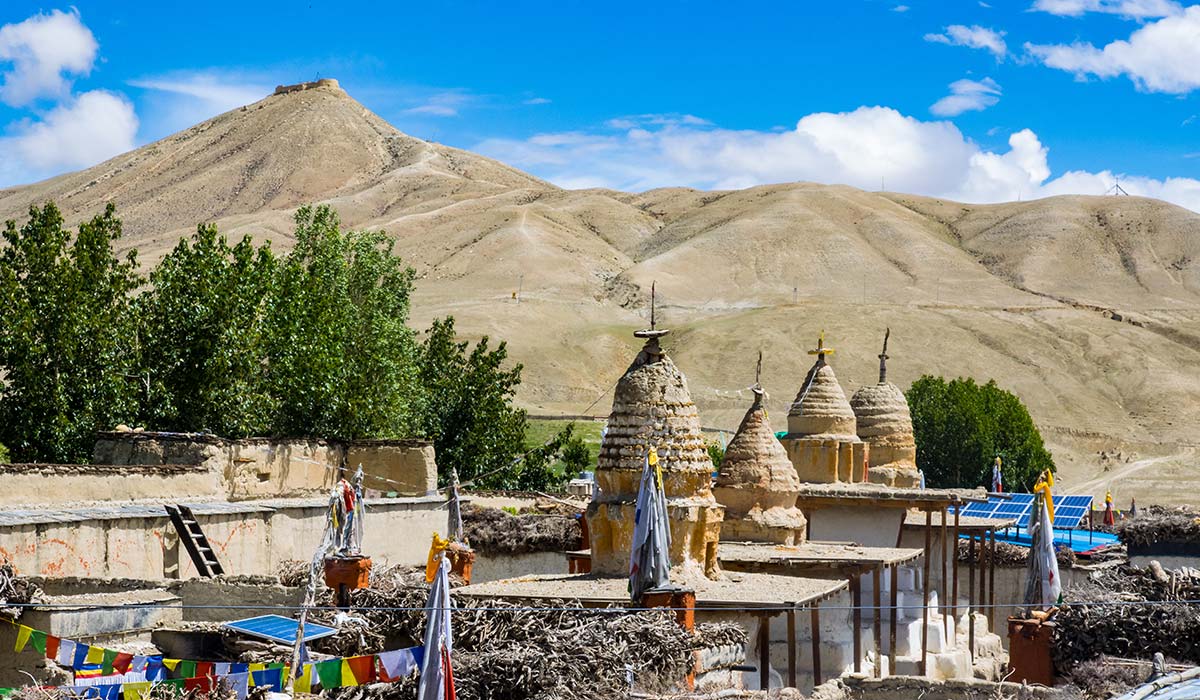
- While traversing the forested trails and vegetated regions in monsoon, there can be bugs and leeches troubling your way. So, wear full-sleeve dresses and carry insect repellent to keep insects away from you.
- Apply SPF 50 + sunscreen over a period of time and wear a brimmed hat while trekking in the summer season to prevent sunburn from intense sunrays.
- Carry proper rain gear like gaiters, waterproof jackets and pants, rain gloves, etc., to stay dry and comfortable during the monsoon treks of the Upper Mustang.
- Due to the monsoon’s impact on the weather, the flights between Pokhara and Jomsom may get postponed or canceled. So, you need to be flexible with your travel plans.
- Check the accommodation availability and make prior reservations before embarking on the Upper Mustang Trek in the peak trekking seasons like spring and autumn.
- As the days in winter are short, start trekking early every day to cover the maximum highlights of the route and reach the destination before dark.
- Photographers and wildlife enthusiasts can enjoy the moment of possible encounters with the melody birds and faunas to the fullest during spring and autumn by taking snaps on cameras and observing the creatures in close range with binoculars.
- Be prepared for the crowded trails during spring and autumn, as these are the busiest times of year to trek in the Himalayan regions, including the Upper Mustang.
Each Season Packing Ideas for Upper Mustang Trek
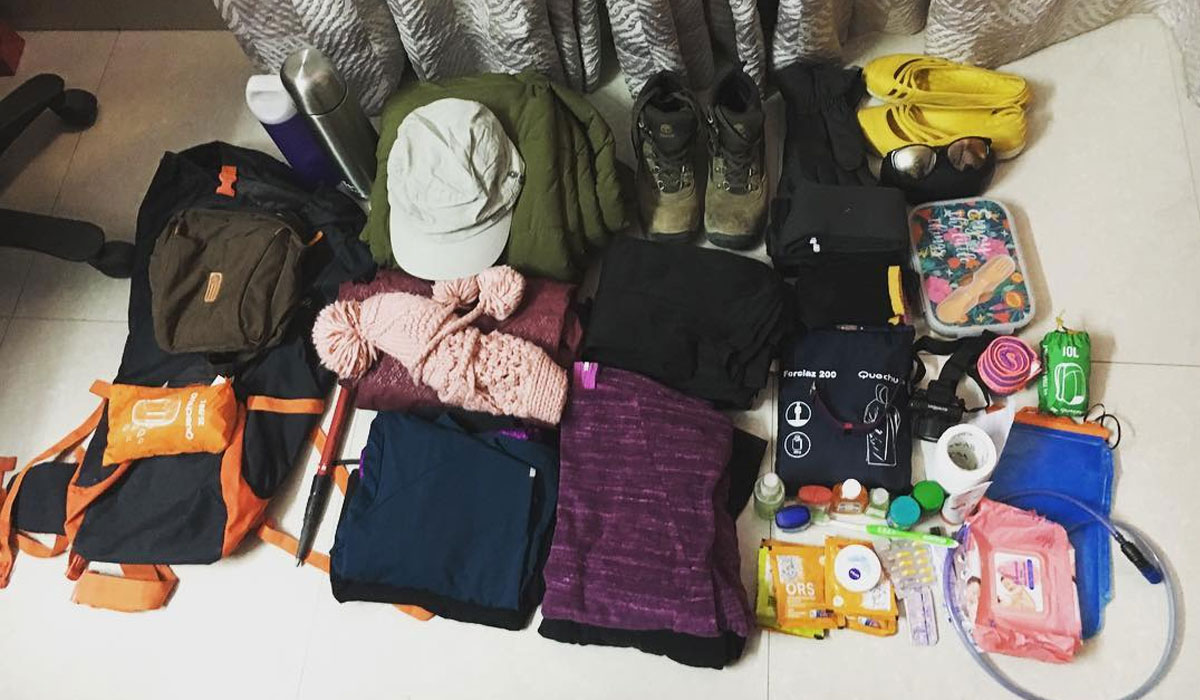
Spring and Autumn: Spring and autumn are the best time for Upper Mustang Trek, presenting similar temperatures and weather patterns. Both these seasons provide a stable climate with moderate heat. While the days are characterized by delightful warm conditions, the mornings and nights at higher altitudes can be notably colder. Therefore, it is advisable to pack a mix of light to medium-weight clothing to comfortably adapt to the fluctuating temperatures and warm and cool climates during this time.
Winter: The winter season presents the lowest temperatures of the year. The biting cold and frequent heavy snowfall blankets the Upper Mustang region in icy conditions. As the temperature plummets, it is essential to pack warm, insulated thermal layers to ensure comfort and safety.
Monsoon/Summer: The monsoon/summer season brings sweltering heat and damp conditions, marked by the scorching sun and recurrent rainfall. Hence, you need to pack the items accordingly to accommodate the hot and humid weather during this time. Generally, carry a mix of lightweight, breathable, and moisture-wicking clothes for hot weather and rain jackets and pants, waterproof gloves, and gaiters for rainy conditions.
